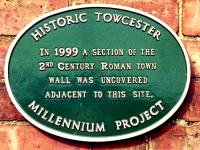For many years it was thought Lactodorum was just a small Roman fort on the Watling Street. Now, archaeology suggests that the town may have been a significant cultural and administrative centre with impressive public buildings.
The unusually powerful wall defences were constructed about 170 A.D. not to protect the inhabitants, but to protect the machinery of state, in this case almost certainly communications and possibly taxation resources such as stored grain. The wall was surrounded by an extensive ditch and earthworks and within its circumference were four gates; two bestriding the Watling Street, an Eastern gate, possibly now surrounded by Bury Mount, and a Western gate guarding the Roman road to Alchester.
From the presumed position and height of the walls some 50,000 tons of stone would have been required. Such a large effort implies that the decision to built the wall came from the governmental, rather than local authorities. Roman pottery of this period found in Towcester is of a type used by the Roman Army, suggesting that the wall may have been built by Roman Army engineers.
The reason for building strong defences was probably due to local insurrection and attacks on Towcester: supporting evidence has been found at Park Street and other sites, and there was a spread of what may have been arson attacks between 160 A.D. and 170 A.D.
In 1999 the foundations of the Roman Town Wall were exposed during the re-laying of the surface of Meeting Lane which leads from Richmond Road to Watling Street. A plaque has been sited on the gable end of 6 Richmond Road to mark the position of the Roman Wall and as a reminder of Towcester's historic origins.
Vivienne Baker, February 2002



